In this week’s “An Obol for Charon,” Star Trek: Discovery makes deft use of the bottle show format to tackle life, death, change… and what it means to be understood by those around you.
The episode begins with the much-anticipated arrival of Number One (Rebecca Romijn), Captain Pike’s first officer from the Enterprise, who comes aboard all too briefly to give him a status update on the ongoing repairs to the ship, last seen being towed away for repairs in “Brother.”
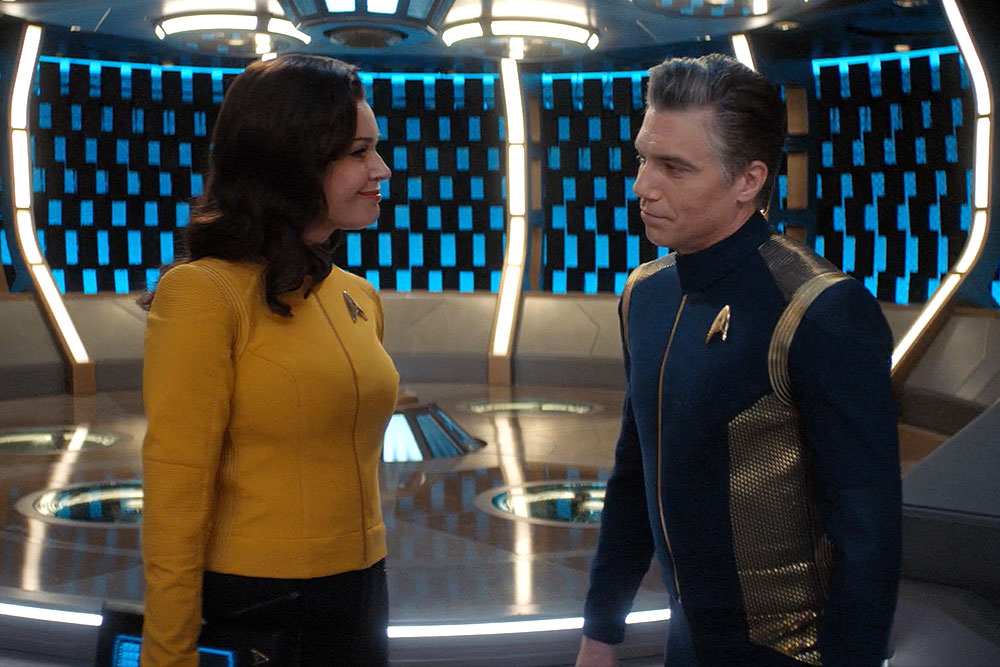
After informing him that the Constitution-class ship’s problems have been traced back to a serious incompatibility with the newly-installed holographic communications system, Pike orders that Chief Engineer Louvier “rip the damned thing out!,” checking the box as to why we don’t see it in use in the Original Series — and giving us the first namedrop of Montgomery Scott’s predecessor in the Enterprise engine room.
The two of them stop by the mess hall where Number One gives Pike an update on Spock’s situation, and offers away to track the Vulcan’s escape from Starfleet, but before their conversation can go much further, Pike is called away to a staff briefing.
Hopefully, Number One got a chance to finish her giant cheeseburger (and habanero-sauced french fries) before she had to return to the Enterprise!
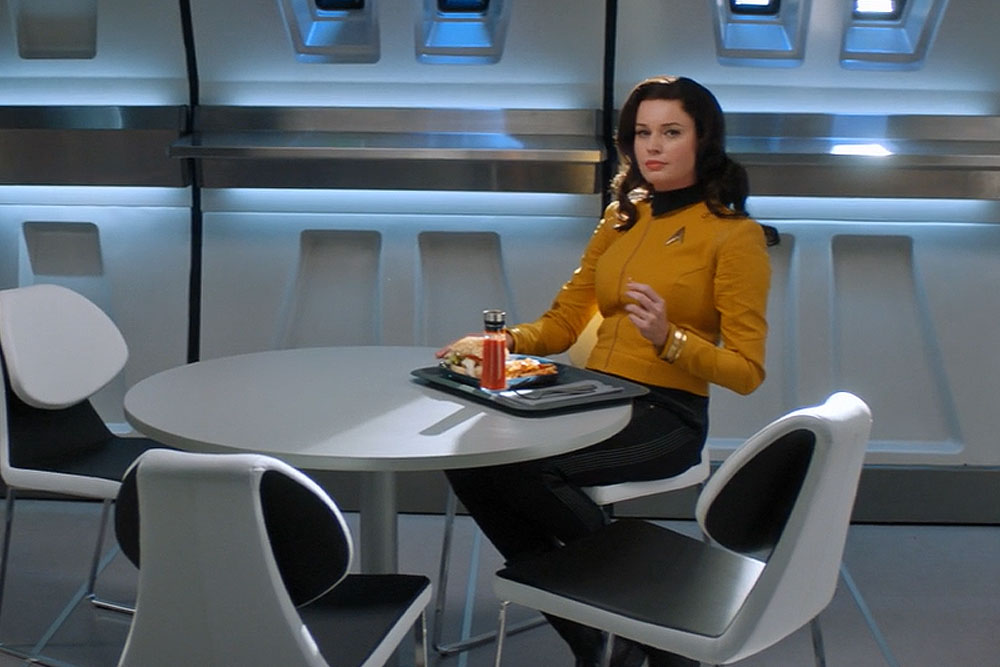
Leaving the Enterprise behind, Discovery sets course to catch up with Spock’s shuttlecraft with Enterprise officer Nhan (Rachael Ancheril) along for the ride, first introduced in the season premiere, taking over Ash Tyler’s security station on the bridge.
The ship doesn’t get very far before being quite literally stopped in its tracks, ripped out of warp speed by an enormous 100,000-year-old mystery sphere. The sphere is holding Discovery in place in some sort of energy field, and is barraging the ship with incomprehensible signals that wreak havoc on the ship’s systems.
The first and most memorable of the malfunctions causes the ship’s universal translator to go haywire, translating all written and spoken words into other languages at random — from Klingon to Italian to Tau Cetian. For a franchise with nearly 800 hours of television and movies under its belt, it’s impressive that the writers were able to come up with a completely original crisis, and doubly so considering it involved a piece of technology that’s been part of Star Trek for over 50 years.

Because Saru speaks more languages than anyone else aboard, something we just happened to learn in “New Eden,” it’s up to him to get the translator issue sorted. Not at his usual post on the bridge, Saru is convalescing in his quarters due to illness.
At first, he brushes his illness off as a common cold — something Kelpiens treat with hot salted tea, which we’ve seen Saru enjoy in the past — but it quickly becomes apparent that something much more serious is going on. Saru has been afflicted with the vaharai, a Kelpien malady that signals when it’s time to be “harvested” by the Ba’ul.
As Saru explains it, those Kelpiens who are not taken by the Ba’ul succumb to madness and eventually death — and as we learned from Saru’s narration in “The Brightest Star,” being harvested “brings the pain of varharai to an end.”
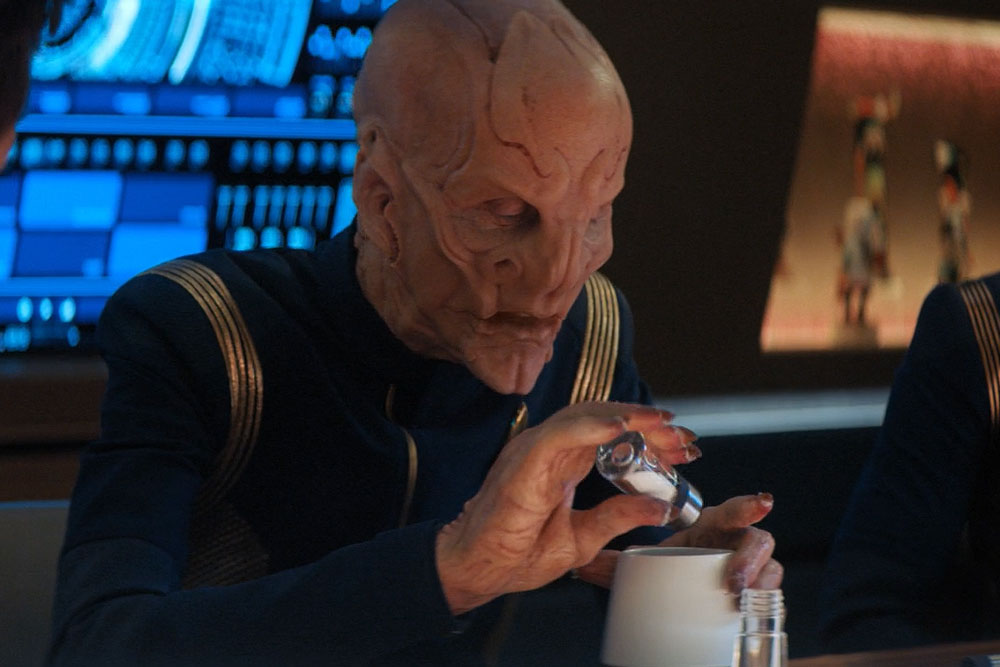
Down in engineering, Jett Reno (Tig Notaro) makes another very welcome appearance. Sent by the still-unnamed Discovery chief engineer to make repairs, she immediately starts butting heads with a rather haughty Paul Stamets (Anthony Rapp), who has little appreciation for the “nuts and bolts” side of starship propulsion.
The writing and performances between the two are excellent; both are quick to throw sharp barbs at one another, but neither stray into genuine disrespect or unprofessionalism — just a well-reasoned argument over the usage of “old-school” antimatter and dilithium crystals — and as soon as the severity of their crisis is made clear, they jump into collaboration mode and never look back.
The primary emergency Reno and Stamets have to deal with involves the fungal blob’s escape from containment and its reattachment to Sylvia Tilly (Mary Wiseman). Presumably to keep Tilly calm, the fungus releases the hallucinogen psilocybin — that is, the “magic” in magic mushrooms — into the observation room where the two of them are being held.
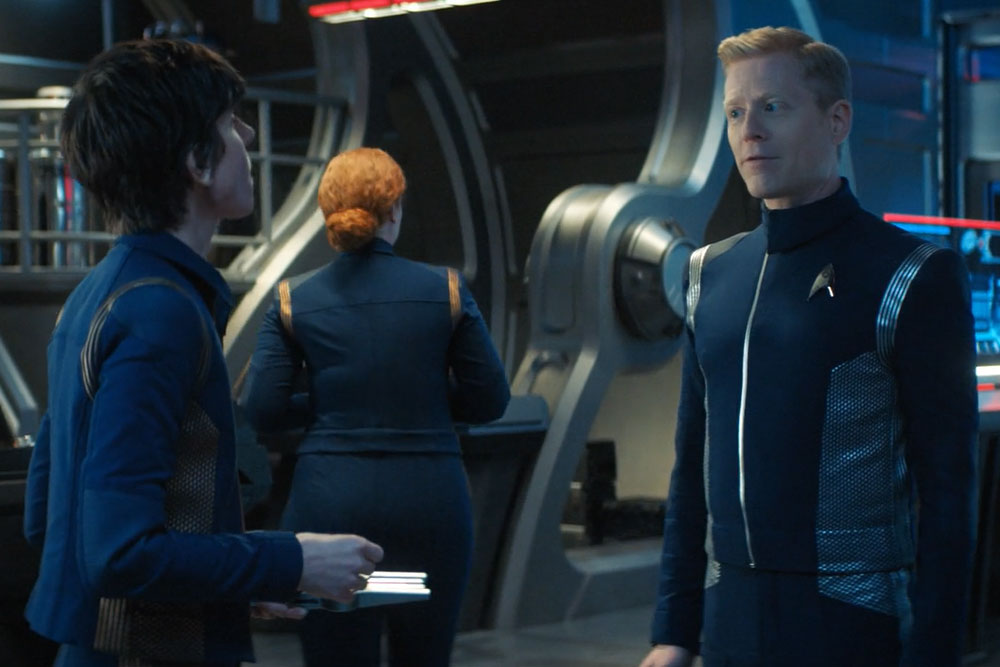
While Tilly trips out, Stamets and Reno jury-rig a cortical stimulator from a handheld communicator so Stamets can communicate directly with the fungus.
Unfortunately for Tilly, the only way to make the cortical stimulator work is to put it in direct contact with her brain, which means an emergency trepanation with a power drill. Thankfully, as her time on the downed Hiawatha demonstrated, Reno is adept at translating her engineering skills to medical situations.
On a side note, if I’m ever on a disabled Starfleet ship and a team of engineers have to perform an impromptu trepanation on me, please properly restrain my head! Tilly had enough to worry about during that scene not to be concerned over adding ‘accidental head movement during drilling operations’ to the list.
(Singing David Bowie’s “Space Oddity” might have been enough to keep Tilly suitably calm, but I would prefer a head strap.)
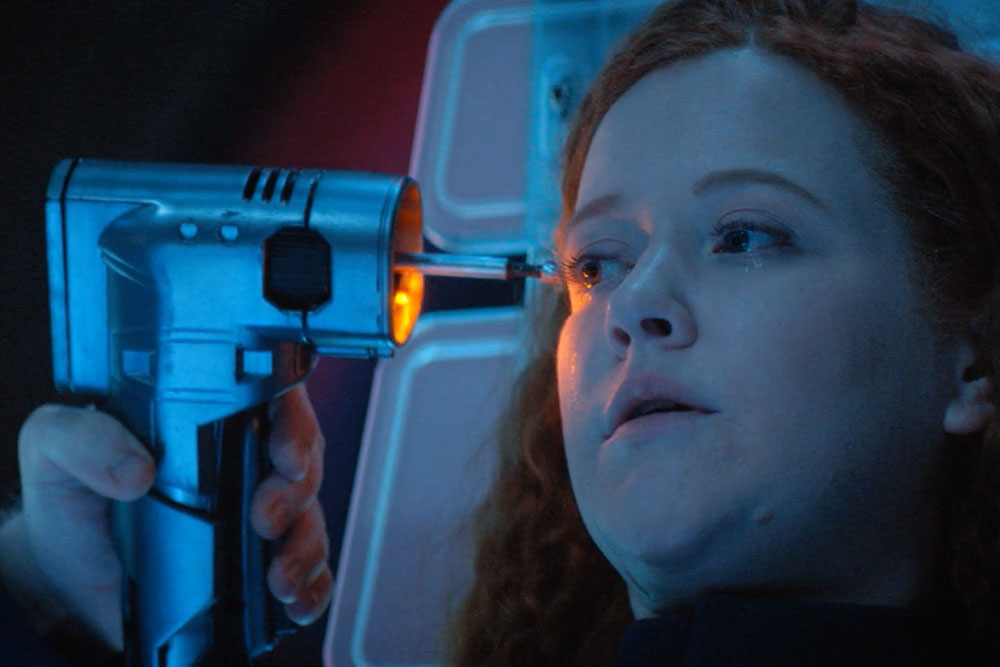
Minor brain surgery complete, Stamets learns that the fungus isn’t simply a benign stowaway, but a sentient being — whose species lives inside the mycelial network — on a critical mission to end Discovery’s spore jumps. Each time the ship jumps, it severely disrupts the ecosystem of this being’s home. Shocked, Stamets vows to close out Starfleet’s access to the network all together.
Bridging Tilly’s mind with that of the eukaryotic hitchhiker allows the “May” creature (speaking with actor Bahia Watson’s voice) to reveal not only the truth about the effects Stamets’ work has had on the mycelial network, but also that she’s “not finished” with Tilly, an ominous moment played quite well by Mary Wiseman, who spends most of this episode giving one of her best performances to date.
Between her caffeine-fueled rambling in “New Eden,” her exhausted breakdown in “Point of Light,” and her alternating moments of fear, euphoria, and possession this week, we’re seeing much more of Wiseman’s range than just the typical bubbly Tilly we’re used to.
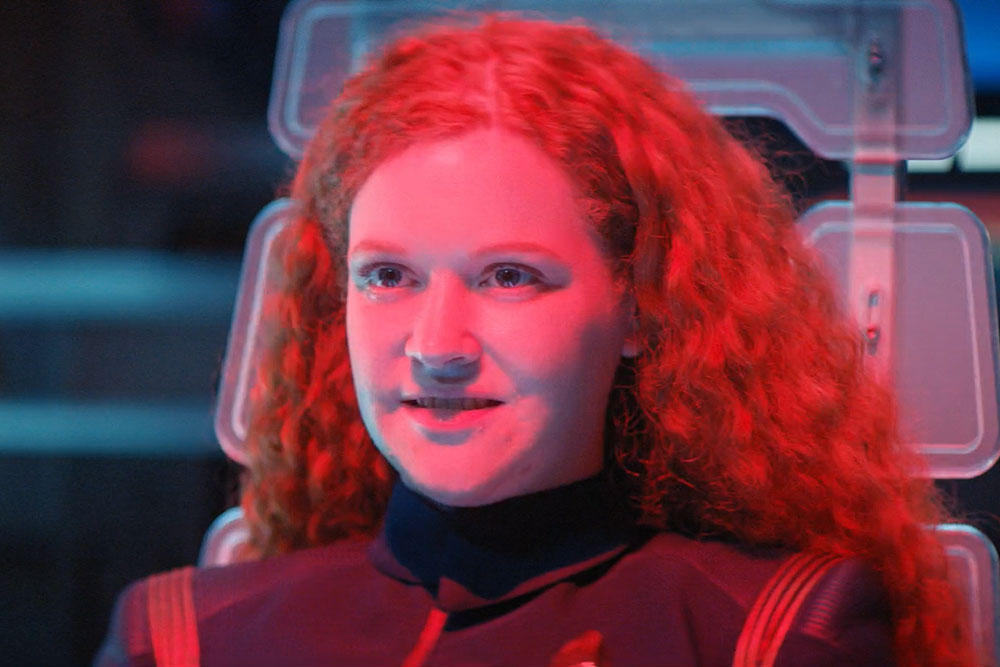
Before Stamets can get more information, however, the fungal blob doses the air again and somehow absconds with Tilly while Stamets and Reno take their own much more psychedelic trip.
However this story arc is resolved, it looks like we’re finally approaching the end of the line for the spore drive, and answering a burning question that’s been flying around fan circles since “Context is for Kings” — where the heck is this technology in Star Trek’s future?
If the spore drive is as damaging to at least one alien species as “May” seems to imply here — combined, of course, with the difficulties in piloting the drive — then it makes a lot of sense why Starfleet abandons the technology as the ethical issues continue to pile up.
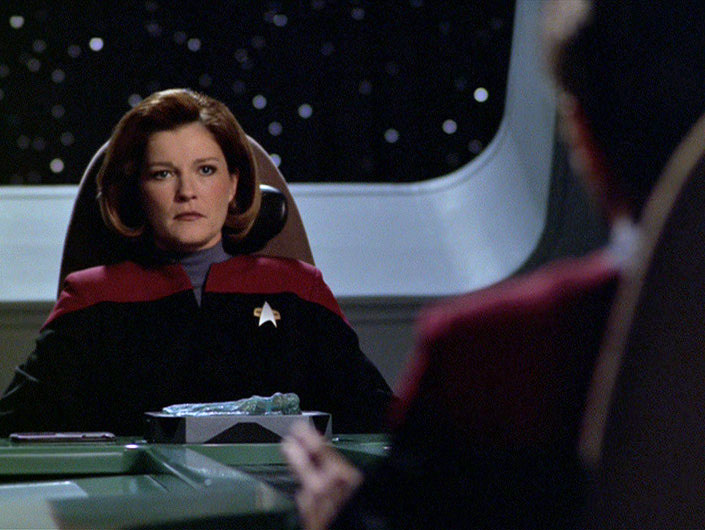
Compare the revelations about the spore drive to moments such as the moral dilemma faced by the crew of Voyager in “Equinox,” who were appalled to learn that Captain Ransom and his crew were knowingly harming innocent alien creatures to fuel their ship.
RANSOM: We traveled over ten thousand light years in less than two weeks. We’d found our salvation. How could we ignore it?
JANEWAY: By adhering to the oath you took as Starfleet officers to seek out life, not destroy it.
RANSOM: It’s easy to cling to principles when you’re standing on a vessel with its bulkheads intact, manned by a crew that’s not starving.
JANEWAY: It’s never easy. But if we turn our backs on our principles, we stop being human.
Can you imagine Captain Janeway, who time and again gave up opportunities for a quick return from the Delta Quadrant because it would have harmed others, knew of the ethical cost of jumping with the spore drive and choosing to use it anyway?
While it’s certainly true that the spore drive was written into Star Trek lore almost two decades after Voyager’s run, the developing complications line up comfortably with the precedent set by that series.

Back up to the bridge, the crew is unclear if the ancient sphere is a ship, an entity, or something else entirely, but one thing about it becomes certain: its fundamental imperative is to pass on its accumulated knowledge prior to its imminent demise.
With Burnham’s help, Saru realizes that the sphere’s “attacks” have actually been attempts at communication, and it’s holding Discovery in place out of a desperate need to complete that communication before it implodes, taking with it millennia of “memories.”
Perhaps the sphere is another of the entities that encountered the Voyager 6 spacecraft in The Motion Picture and became V’Ger, this time merged with an organic being of some kind? Whatever it is, its time of exploration has come to an end, and it will do everything in its power to ensure that that time is not forgotten.
Like Saru’s request to Burnham that she preserve his journals so that they may someday be returned to Kaminar, the sphere seeks the “eternal life” that comes from being remembered. After spending 100,000 years as a data collection device, it is now time for the sphere to transition into data transmission mode, and all Discovery has to do is lower its shields and wait a few minutes for the data to transfer.
The dilemma is, of course, that in those same few minutes Spock’s shuttle will slip out of sensor range and be lost forever. Pike concedes, the sphere’s dying purpose is fulfilled, and it explodes — and don’t worry, we still know where Spock is.
In its last moments, the sphere recorded Spock’s location beyond the range of Discovery’s sensors, so the chase can continue.
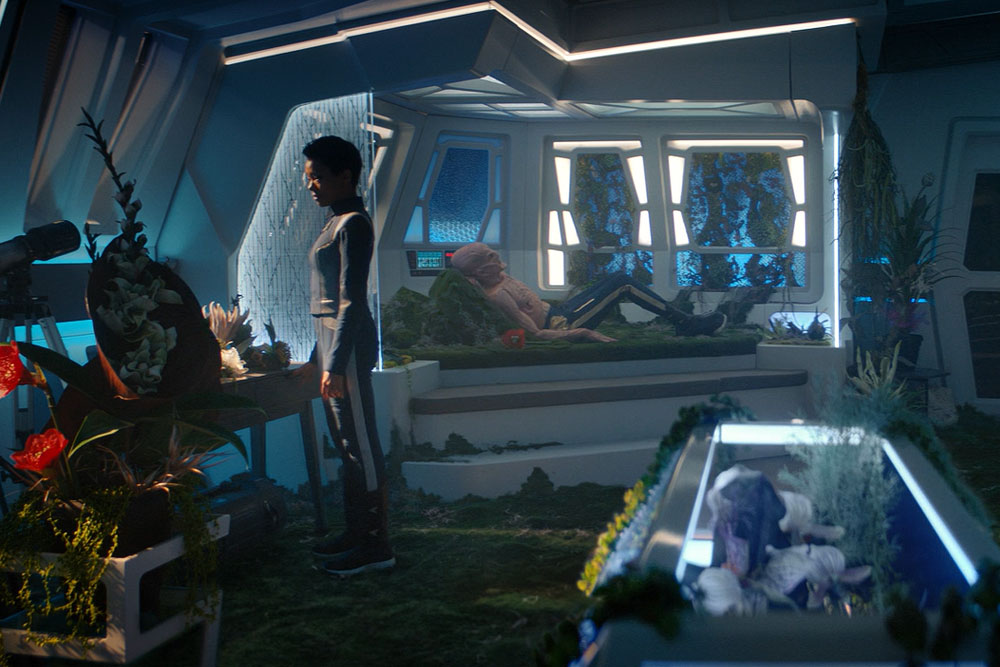
“An Obol for Charon” features more screen time between Burnham and Saru than we’ve gotten in quite a while, and clearly demonstrates that the schism between the two that marked much of last season has been mended.
Throughout the episode, Burnham and Saru work diligently to figure out the sphere’s intentions and how to break free of its grasp, but their work also serves as a way for Saru to distract himself with the demands of his duties and for the two of them to spend a few remaining moments together as colleagues and friends.
As a way to curb his suffering during what he believes to be his last few days of life, Saru asks Burnham to slice off his inflamed threat ganglia. This is, apparently, a very intimate act, and not simply a palliative procedure that can be performed in sickbay. Before completing the act that signifies Saru’s impending death, Saru and Burnham express the closeness of their relationship with one another. Sobbing, Burnham calls Saru her family and Saru confides that Burnham has become a sister to him.
As touching as this moment was, I’m not sure that it had really been earned by what we’ve seen on screen. When, exactly, did Saru and Burnham become this close? I’d explain this away with the possibility that the two were extremely close while serving aboard the USS Shenzhou, but Burnham was a much more stoic, Vulcan version of herself at the time so that doesn’t really fit either.
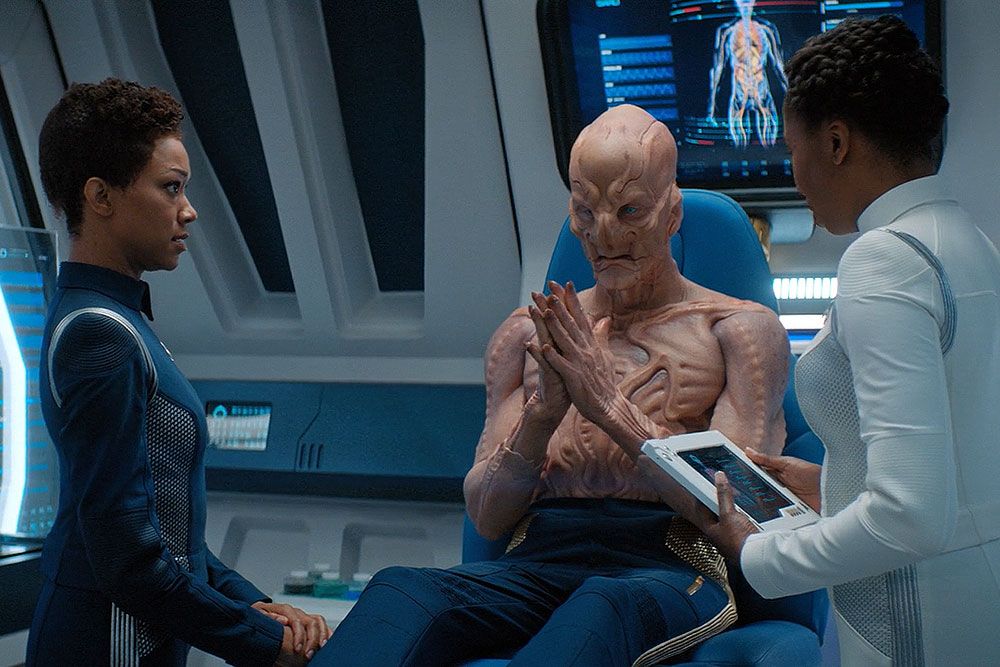
Just as Burnham is about to perform this final act for Saru, his threat ganglia shrivel and fall out on their own. The terminal illness that Saru’s people have spent their existence fearing has spared him. What does this mean?
In Greek mythology, a coin — the obol — is traditionally paid by the souls of the dead to the ferryman Charon in exchange for his services transporting them across the river Styx to Hades, the land of the dead. In its most specific sense, an obol for Charon is the token needed to complete the journey from life to death, but in a broader sense it is the cost of transition from one state of being to the next.
Those who cannot pay it are doomed to wander the wasteland between worlds, unchanging and without ultimate control over their fate. Unlike the Kelpiens, who remain behind on Kaminar, Saru has managed to leave the wasteland. He paid the ferryman not with a coin, but with the certainty that the fate of the Kelpiens back on Kaminar could not change.
Now that he’s across the river, Saru must live with the knowledge that everything he held to be true about his culture and his people is a lie. The vaharai is not a death sentence, and the Ba’ul’s culling of Kelpiens isn’t the profound sacrifice it seems to be.
Both on a biological level and a metaphysical one, Saru has entered a new phase of his life and is free to live without fear. I’m interested to see how this changes him, but hope the ferryman’s toll wasn’t so high that he can no longer be the beacon of optimism that he’s always been.
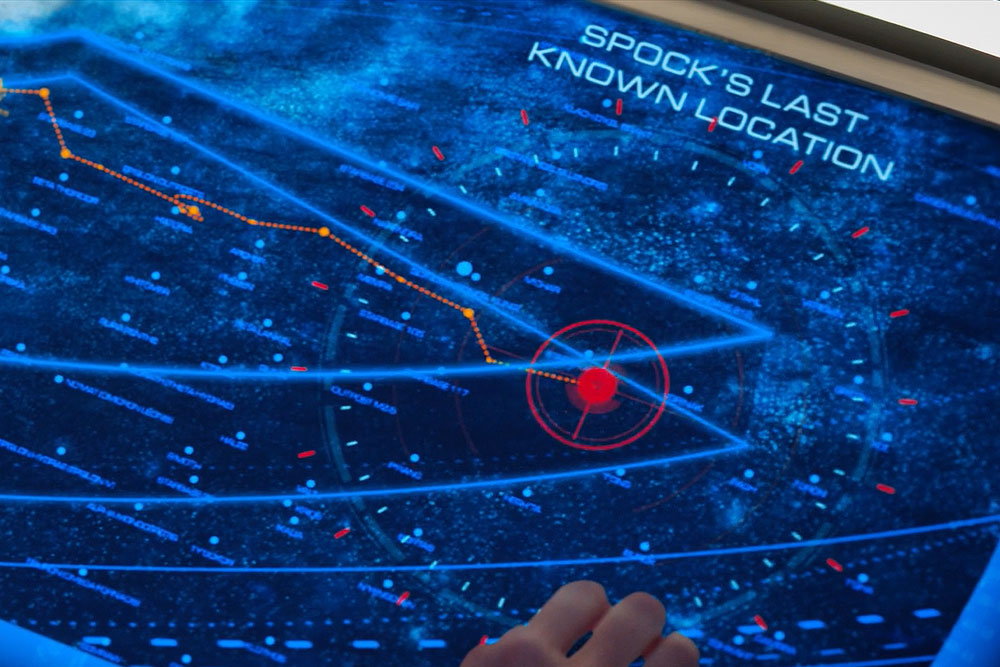
We know that at some point this season, Discovery will head to Kaminar for more follow-up on the story which began in “The Brightest Star.” Will we learn that the Ba’ul have simply been taking advantage of the Kelpien’s naivete to further their own goals? Will this deception impact Starfleet’s application of General Order 1 to Kaminar?
Hopefully, we’ll get some more traction on all of these ongoing stories — Tilly’s disappearance, the culling on Kaminar, and the seemingly unending search for Spock — when Star Trek: Discovery returns next week in “Saints of Imperfection.”
![]()
What did you think of “An Obol for Charon”? Sound off in the comments below!
